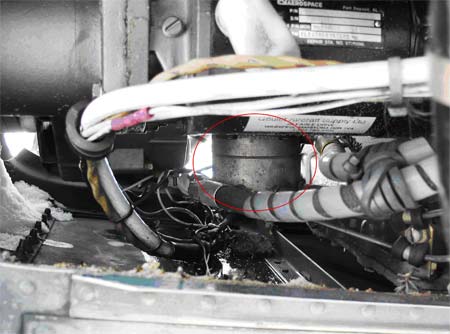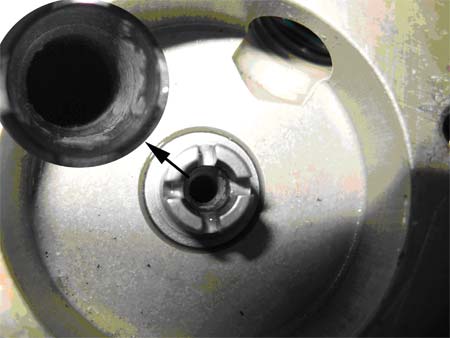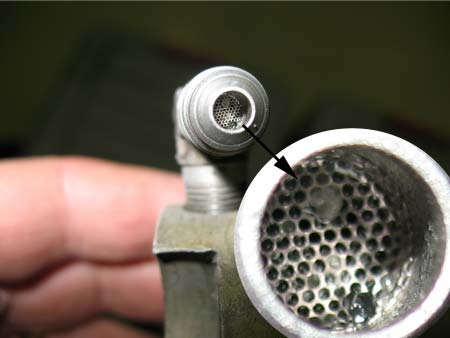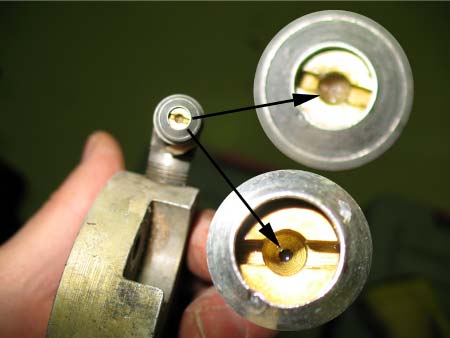Double Engine Power Loss
Hicks & Lawrence Limited
Aero Commander 500B C-GETK
Armstrong, Ontario, 20 nm SW
The Transportation Safety Board of Canada (TSB) investigated this occurrence for the purpose of advancing transportation safety. It is not the function of the Board to assign fault or determine civil or criminal liability. This report is not created for use in the context of legal, disciplinary or other proceedings. See Ownership and use of content. Masculine pronouns and position titles may be used to signify all genders to comply with the Canadian Transportation Accident Investigation and Safety Board Act (S.C. 1989, c. 3).
Summary
The Hicks & Lawrence Limited Aero Commander 500B (registration C-GETK, serial number 500B-1093-56) departed from Dryden, Ontario, en route to Geraldton, Ontario. The flight was conducted under visual flight rules at 5500 feet above sea level with ambient temperatures aloft of -33°C. Approximately 40 minutes into the flight, the crew observed an abnormal right engine fuel flow indication. While troubleshooting the right engine, the engine rpm and fuel flow began to decrease and the crew diverted toward Armstrong, Ontario. A short time later, the left engine rpm and fuel flow began to decrease and the crew could no longer maintain level flight. At 0917 central standard time, the crew made a forced landing 20 nautical miles southwest of Armstrong, into a marshy wooded area. The captain sustained serious injuries and the co-pilot and passenger sustained minor injuries. The aircraft was substantially damaged. The crew and passenger were stabilized and transported to Thunder Bay, Ontario, for medical assistance.
Factual information
Hicks & Lawrence Limited operates a fleet of Aero Commander 500 series aircraft that are used to support the Province of Ontario's forest fire management program. The company provides airspace and aircraft management (birddog) services and aerial fire surveillance (detection). The aircraft are normally operated during the summer fire season, and are parked in a hangar over the winter months. The accident aircraft was last flown on 13 September 2007. After that flight, the aircraft was fully fuelled from a commercial fuel supplier and then parked inside the company's heated hangar in Dryden, Ontario.
The accident aircraft underwent a 12-month annual inspection and servicing, which was completed on 21 November 2007. All maintenance items were up to date and there were no outstanding defects or unserviceabilities. The left fuel boost pump was replaced due to low pressure output. To facilitate the replacement of the pump, the aircraft was defuelled using the company's fuel bowser. After the pump was replaced, the fuel from the bowser was put back into the aircraft. The fuel bowser is equipped with an internal standpipe as well as a dirt and water filtration system. A fuel sample was taken from the fuel bowser after the accident (below the standpipe level) and no indication of contamination or standing water was found. The sumps of three other Aero Commander aircraft that had been stored in the hangar for an extended period of time were drained and checked for water. No visible water was noted.
The purpose of the occurrence flight was to pick up one of the company's aircraft that had been stationed in Geraldton, Ontario, for the summer, and to reposition it to the company base in Kenora, Ontario. On the morning of the occurrence, the crew members arrived at the hangar and began their pre-flight duties. One of the crew members completed the flight planning while the other crew member conducted a pre-flight inspection of the aircraft. The aircraft's weight and centre of gravity were checked and were found to be within approved limits. The pre-fight inspection included the draining of the fuel sumps. The pilot used a clear fuel sampling cup to drain and check the engine fuel filter bowl drains. Both filter bowls were clear and free of water or contamination. The pilot drained the main fuel tank sump, but did not collect a fuel sample.
The 0815 central standard timeFootnote 1 automated aviation weather report for Dryden was as follows: wind 250° true at 3 knots, visibility 9 statute miles, a few clouds at 400 feet above ground level (agl) and scattered clouds at 800 feet, temperature -25°C, and dew point at -29°C. The temperature aloft at Armstrong, Ontario, at 6000 feet was -33°C.
The aircraft was pulled from the hangar and the pre-take-off run-up was normal. The aircraft took off under visual flight rules at 0830 and climbed to 5500 feet above sea level (asl). Both engines were leaned for best economy cruise flight. Approximately 30 minutes into the flight, the engine fuel flow readings began to fluctuate and the crew continually advanced the engine mixture controls until they were in the full rich position. Approximately 10 minutes later, the right engine fuel flow began to decrease and the engine began to lose power. The crew turned on the fuel boost pumps, but the fuel flow did not change. The aircraft was approximately 40 nautical miles (nm) away from Armstrong and the crew decided to divert to the Armstrong aerodrome. Approximately three minutes later, the left engine fuel flow began to decrease until both engines were at or near idle power with the throttles in the full open position.
The aircraft could not maintain altitude, and the crew attempted to land the aircraft in a marshy snow-covered clearing approximately 20 nm southwest of Armstrong. The crew kept the aircraft configuration clean, with the landing gear and flaps retracted. The aircraft touched down on its belly and slid for approximately 50 yards before the right wing struck a tree and spun the aircraft sideways. The pilot was thrown against the door structure and was seriously injured. The remaining two occupants received minor injuries. Search and rescue (SAR) was alerted by an emergency locator transmitter signal and SAR technicians were sent to the site.
During examination of the aircraft at the accident site, a restriction or blockage was found in the fuel supply to both Lycoming I0-540-B1A5 engines. The left engine had a partial blockage with no fuel supply to the forward cylinder nozzles; the right engine had a complete blockage with no fuel supply to any of the cylinder nozzles. The blockage was determined to be within the fuel distributor valve(s) because fuel pressure was present upstream of the valves (see Photo 1). The location of the fuel distributor valve on the IO-540-B1A5 Lycoming engine, in conjunction with the Aero Commander 500B engine cowling configuration, exposes the valve directly to the cooling blast of the outside air.
The right engine fuel distributor valve was removed and examined. Ice was found adhering to the internal main metering well surface (see Photo 2). Ice formed from super-cooled water droplets was also found adhering to the servo bleed screen and fully covering and blocking the return-to-tank bleed orifice (see Photos 3 and 4).
All aviation fuels absorb moisture from the air and contain water in suspended particles and in liquid form.Footnote 2 The suspended water comes, in part, from atmospheric moisture that is trapped within the air spaces of the fuel tanks and introduced through the fuel vent system. This moisture condenses on the fuel surface and is absorbed by the fuel. Excess moisture sinks and settles to the bottom of the tank or sump area to be drained away. Fuel saturation levels vary by grade, pressure, and temperature with warmer fuel capable of containing a higher level of dissolved water.
High altitude testing of piston engines on pressurized aircraft was carried out by a major aircraft manufacturer during the early 1970s.Footnote 3 Numerous partial and isolated total engine power losses were experienced during this test project. The tests concluded that, as the aircraft climbed to the colder altitudes, dissolved water in the fuel precipitated out of solution due to an agitation of the fuel as it passed through the fuel pump and/or vapour separator.
The precipitated moisture, in the form of super-cooled water droplets, emerged from the pump and was carried through the fuel injection metering unit to the fuel distributor valve. At the bottom of the distributor valve plunger well, a significant reduction in flow velocity occurred that combined with a reduced fuel distributor valve surface temperature (due to the cooling air blast against the forward face of the valve) to promote the formation of ice crystals. These ice crystals continued to capture the super-cooled water droplets until the ice build-up blocked the fuel flow to the forward fuel injection lines, causing a reduction in engine power.
In extreme cases, all of the nozzle ports could become blocked. Small ice formations were also observed at the bottom and side surfaces of the fuel distributor plunger (main metering) well. When melted, the ice accumulation represented less than two drops of water. This ice blockage phenomenon was considered capable of affecting most fuel injection systems in service at the time and was eliminated in part by the adoption of fuel additive icing inhibiters, which bond with and reduce the freezing point of the water.
In October 1972, the Commander Division of the then Gulfstream American Corporation released Service Letter 254 and subsequently Service Letter 254A, dated 05 April 1973, allowing the use of an anti-icing and biocidal fuel additive such as Prist® in all two-engine Commander aircraft equipped with Lycoming engines. Lycoming issued a similar Service Letter with the current revision being L172C, dated 21 February 2005, to allow the use of fuel additive icing inhibiters ethylene glycol monomethyl ether (EGME) such as Prist® and diethylene glycol monomethyl ether (DIEGME or DEGMME) in all Lycoming engines.
A review of the Hicks & Lawrence Limited operations manual found that the company had no procedure in place detailing the usage of a fuel additive icing inhibiter in its fleet of Aero Commander aircraft. The aircraft in this occurrence was being operated without a fuel additive icing inhibiter.
Analysis
The aircraft had been fuelled from a commercial fuel supplier approximately 2 ½ months before the occurrence and was stored in a warm hangar. On the day of the accident, the sumps were drained and no visible water was noted. Fuel samples were taken from the sumps of three other Aero Commander aircraft that had been stored in the hangar for an extended period of time. No visible water was noted. The higher fuel temperatures associated with the inside storage of the aircraft would have increased the fuel's saturation level, resulting in a higher amount of water held in suspension. The water held in suspension would not have been visible during fuel sampling.
The location of the fuel distributor valve on the IO-540-B1A5 Lycoming engine, in conjunction with the Aero Commander 500B engine cowling configuration, exposes the valve directly to the cooling blast of the outside air. Generally, cooling of the fuel distributor valve is desired in warm ambient operations. However, in extremely cold conditions, the exposure of the valve directly to the cold airstream can lead to the freezing of super-cooled water droplets present in the fuel stream. The high altitude testing of piston engines conducted in the early 1970s identified the risk of ice accumulations in the fuel distributor valve associated with cold weather operations. The use of a fuel additive icing inhibiter mitigated the risk by bonding with and reducing the freezing point of the water.
The operator's fleet of Aero Commander aircraft is used primarily for summer operations with limited winter usage. The operator did not have procedures to describe how a fuel additive icing inhibiter should be used during winter operations. The use of fuel additive icing inhibiters is approved both by the airframe and engine manufacturer, and is referenced in the Airmanship section of the Transport Canada Aeronautical Information Manual (TP 14371E). The use of a fuel additive icing inhibitor would have mitigated the risk of fuel system blockage.
The flight was conducted under extremely cold ambient conditions with temperatures at altitude near -33°C. The fuel contained water that was held in suspension. As the flight progressed and the fuel cooled, water precipitated out of solution and froze in the fuel distributor valve. This blocked the fuel supply to the fuel nozzles and led to the loss of engine power.
Findings
Findings as to causes and contributing factors
- Suspended water in the fuel system precipitated out of solution and froze in the fuel distributor valve. This blocked the fuel supply to the fuel nozzles and led to the loss of engine power.
- The aircraft was being operated without a fuel additive icing inhibiter. Use of such an additive would have inhibited ice formation in the aircraft's fuel system and would likely have prevented the fuel system blockage.
Findings as to risk
- The fuel distributor valve on the Aero Commander 500B is exposed directly to the cooling blast of the outside air, which under extremely cold conditions, can lead to the freezing of super-cooled water droplets present in the fuel stream.
- The operator did not have procedures to describe how fuel additive icing inhibiter should be used during winter operations.
Safety action
Safety action taken
Hicks & Lawrence Limited mandated the use of fuel additive icing inhibitors in conditions where the ambient temperature, either at the surface or at altitude, is less than 0°C. The use of fuel additive icing inhibitors has been incorporated into the company operations manual, sub-section 4.2.2, Fuel Anti-icing Additives. The company plans to introduce mandatory training on the use of fuel additive icing inhibitors in the fall of 2008.
This report concludes the Transportation Safety Board's investigation into this occurrence. Consequently, the Board authorized the release of this report on .



